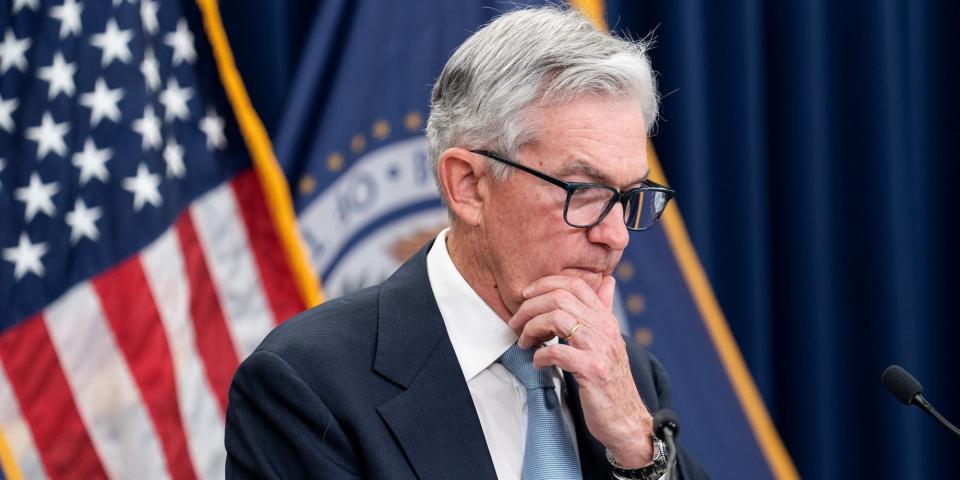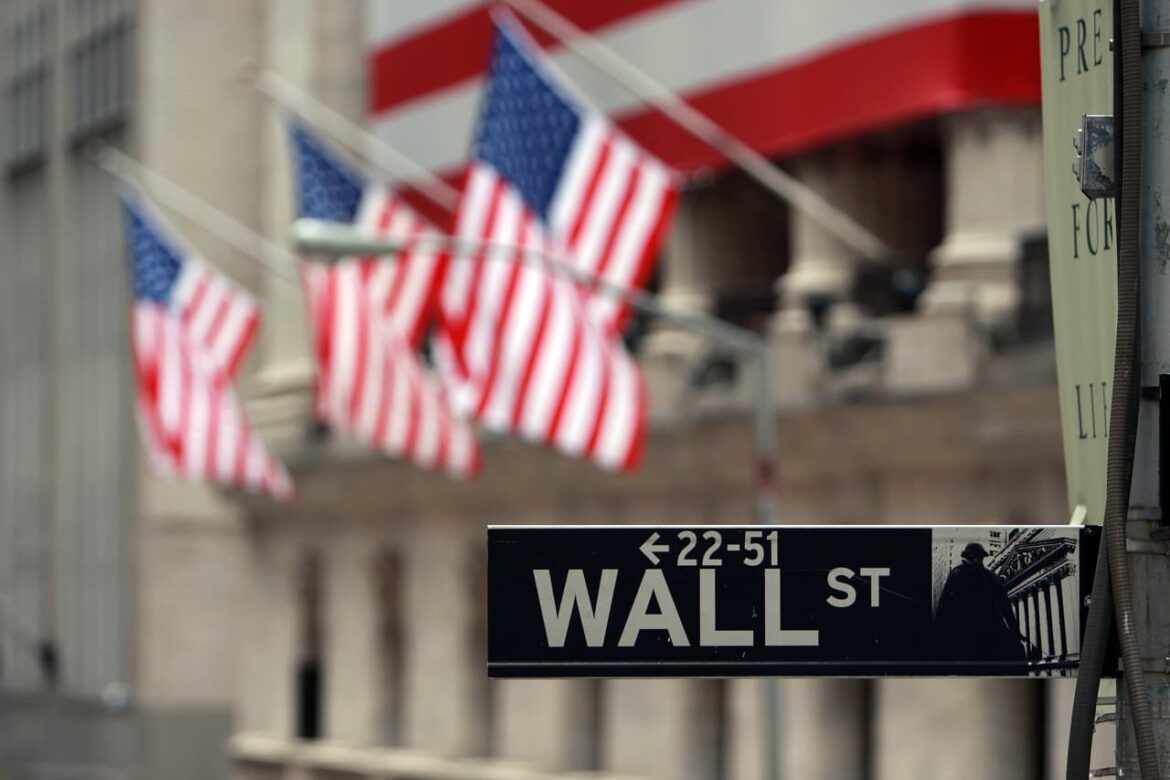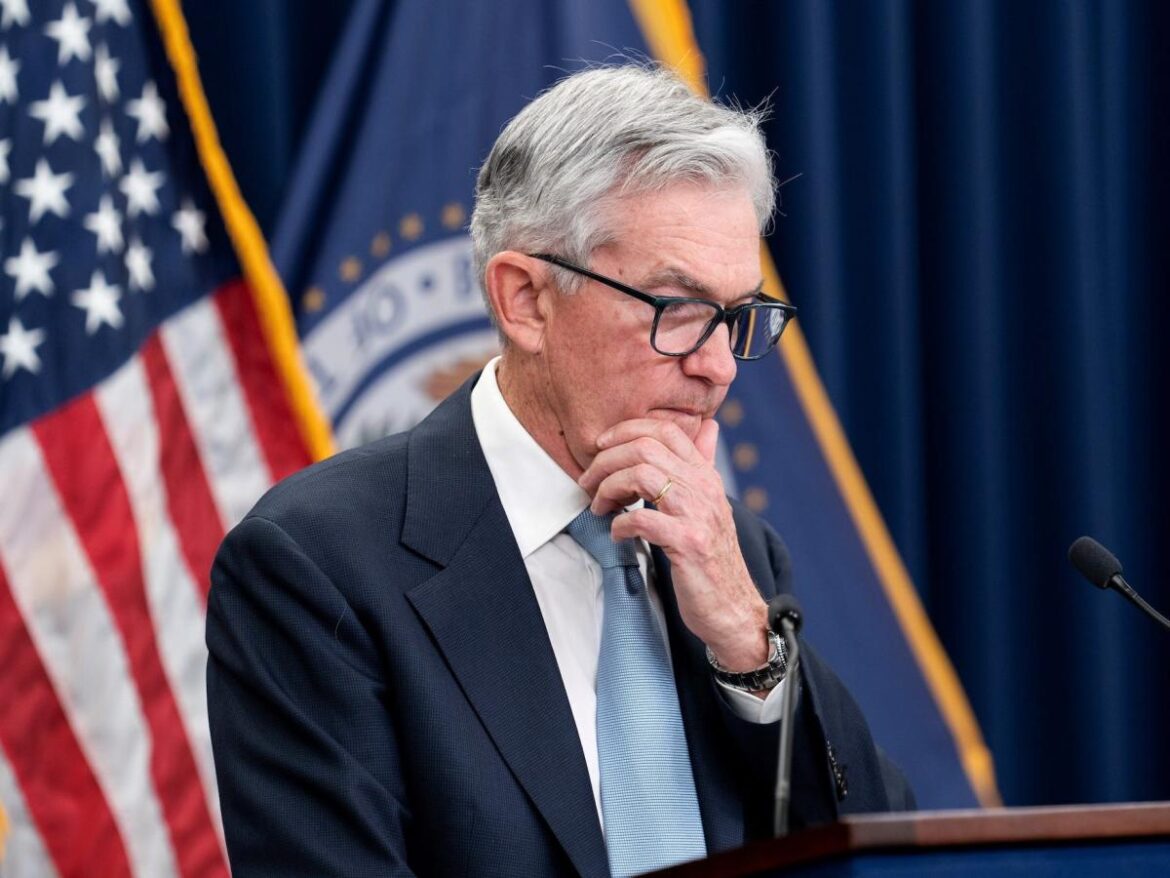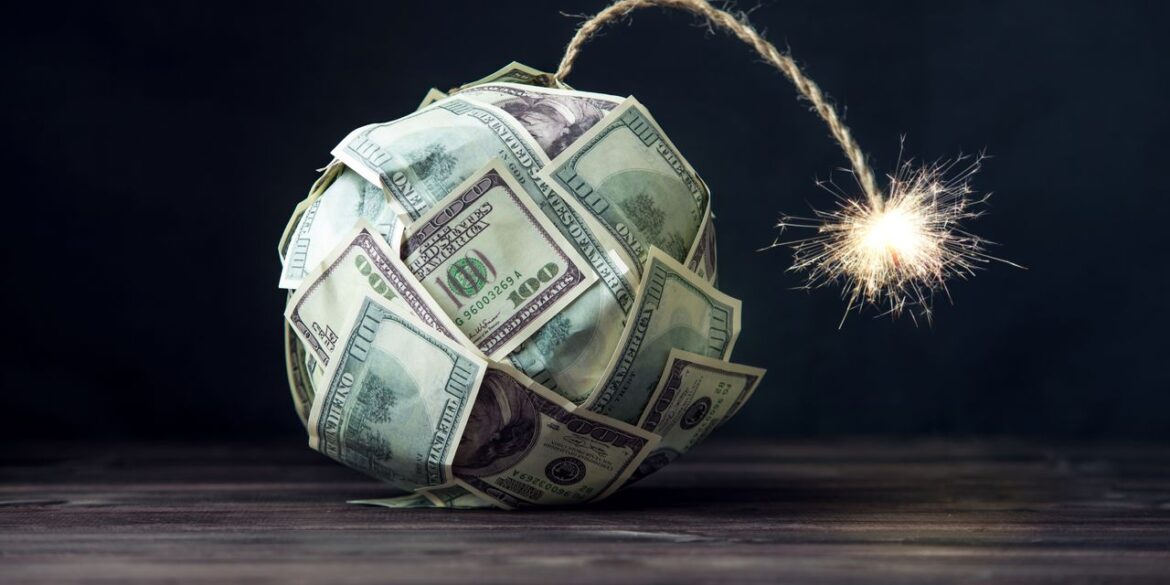
BofA’s Tal Liani upgraded Cisco shares, cheering the company’s opportunity to benefit from networking growth on the heels of market-share gains.
Source link
BofA
Markets are now betting the Fed is going to make a mistake with rate cuts, BofA says

-
Markets are now betting the Fed is going to make a mistake with rate cuts, BofA says
-
While prospects of a March rate cut have dimmed, investors still expect aggressive rate cuts this year.
-
“Markets are still pricing about six cuts over the course of this year. This suggests to us that they are pricing in a policy error.”
Jerome Powell probably wanted to reduce some investor bullishness with his comments about a March rate cut at the Fed’s January meeting. Instead, markets are now betting the Fed is going to make a mistake, according to Bank of America.
“Markets are pricing a policy mistake,” analysts wrote in a note Friday.
The Fed signaled this week that a March rate cut is unlikely, with Powell insisting there needs to be a continuation of “good data” to bring an end to the pause in interest rate hikes. But that didn’t dim investor optimism about cuts for the rest of the year.
“Powell’s strong statement about March lowered pricing of a March cut, but markets are still pricing about six cuts over the course of this year,” Bank of America analysts wrote. “This suggests to us that they are pricing in a policy error.”
Previously, central bank officials have said they foresee about three rate cuts in 2024. And yet, markets have continued expecting more, with some predicting as many as six cuts. Investors were also more optimistic about the timing of the cuts, hoping that the first cut would arrive early. The CME FedWatch Tool showed traders were wagering a 70% chance the Fed would pivot in March early last month.
The data now says traders place the odds that the Fed will hold rates steady in March at over 80%. But they still expect aggressive cutting in 2024 for a total of around 100 basis points.
“Going into the January meeting, we thought it was more important for the Fed to push back against market pricing of the speed of rate cuts rather than the timing of the first cut,” the analysts wrote. “Yet the Fed achieved the exact opposite.”
Wall Street bulls like Tom Lee were also more certain about rate cuts after Powell’s hawkish remarks this week. Others think the real mistake is a Fed that cuts too early.
“If the Fed wants to cut rates at a quarterly pace, it has a lot of work to do in terms of moving market pricing, and it runs the risk of inducing meaningful financial tightening,” the analysts wrote.
Read the original article on Business Insider
BofA reveals rent is cheaper than mortgages in all but two of 97 major metros
This housing market has Bank of America economists in a Shakespearean mood about the eternal debate: The slings and arrows of buying versus renting. In a recently released Hamlet-esque research note, “To buy or not to buy, that is the question,” BofA economists found that buying, to paraphrase the prince of Denmark, is an outrageous fortune these days.
Mortgage rates have created a sea of troubles for homebuyers, hitting the once-unthinkable 8% mark before falling for weeks in the wake of cooler-than-expected inflation reports and the prospect of an end to the Federal Reserve’s rate hiking cycle. While that’s nobler in the mind in terms of affordability, home prices have still risen substantially in just three years, and consumers don’t think it’s a good time to buy, the economists said, citing a University of Michigan consumer sentiment survey. The economists also suggested that buyers should anticipate the undiscovered country of a higher-for-longer rate environment (echoing other investment banks who have said as much.)
At the same time, rents have gone up substantially as well—only recently has rent growth slowed as the rental market softens. “It clearly has not been a buyers’ market due to low affordability, but the situation has not been all that much better in the rental market,” they wrote in the note.
‘Rent was still cheaper than mortgages in all but two’
The BofA economists took a look at the rent versus buy conundrum, comparing rent and mortgage payments (they included property taxes in their calculation, but excluded home insurance, utilities and maintenance costs). Nonetheless, their analysis found that “rent was still cheaper than mortgages in all but two of 97 major Metro Areas,” as of October, despite the fact that both rents and mortgage payments have gotten more expensive, relative to median income, since the pandemic. It’s not hard to understand this, given that the whips and scorns of the pandemic let millions perchance dream of a different way of life—and a different housing situation, sending home prices up more than 40% nationwide and fueling a rent spike that has settled down faster than the buying market.
There’s the rub: It’s worse in some places than others. Along the west coast, economists found it more expensive to purchase a home than rent in cities like Los Angeles, where as a percentage of median income, mortgage payments and tax are 83% and rent is 41%; or San Jose, where it’s 80% versus 26%; or San Francisco, where it’s 71% versus 29%; or San Diego, where it’s 74% versus 38%; or Seattle, where it’s 55% versus 25%.
But there’s also cities like New York, where it’s 62% versus 43%. Meanwhile, New Orleans and Jackson, Mississippi, are the only two cities that are less expensive to buy than rent, according to their analysis.
Realtor.com’s recent rental report, published in late-October, found that for the fifth straight month, rents dropped. “It’s become more economical to rent than to buy in nearly all major markets,” Danielle Hale, chief economist at Realtor.com, said in a statement, at the time. An earlier report showed the cost of buying a starter home was significantly more expensive on a month-to-month basis than the cost of renting a similar-size home; that was true in 47 of the top 50 metros.
The equity question
But then BofA’s pale cast of thought turns to the question of equity. When you buy a home, you build equity over time, all the while the value of your home appreciates. Your home becomes a sort of cash reserve into which you can tap. None of that is true for renting, but that doesn’t mean it’s not a viable option, particularly at this moment.
“A similar story applies to the United States as a whole,” they wrote. “Despite the costs of renting and homeownership both increasing, renting is more affordable than owning. On a national basis, rents have increased from 23% to 26% of median U.S. household income, while the ratio of mortgage payments to income has grown from 19% to 32%.”
The data suggests a housing market that has become “more burdensome” on the average buyer than pre-pandemic—one that’ll take some time before achieving a balance between supply and demand. The investment bank expects the Fed to cut rates next year, and after, they wrote, housing activity should pick up amid improved demand and supply. That being said, the economists expect both existing home sales (which are at their slowest pace in over a decade) and new home sales to “warm up” in the second half of next year, along with more building to support housing starts. In other words, BofA is betting against conscience making (housing) cowards of us all.
This story was originally featured on Fortune.com
Boomers won the housing market and millennials got screwed, BofA says. ‘Everyone locked in 3% mortgage rates, except Millennials’
The unlucky (and sad) millennial housing story may be getting tedious and repetitive, but maybe millennials have reason to be upset. Just consider this, they’re constantly getting crushed in the housing market, and boomers keep coming out on top. Even one of the biggest investment banks on Wall Street thinks so.
There’s been a “massive wealth transfer from the public to the private sector,” Bank of America Research strategists led by Ohsung Kwon wrote in a new note, resulting from two things: Government debt has risen from 31% of the gross domestic product to 120%, from 1980 to today, and 10-year treasury yields had gone from 12% to 4.6% at the time of writing (the 10-year treasury was sitting at 4.9% as of press time). Add it all up and household wealth increased from $17 trillion to $150 trillion, a record high.
The winners of this great wealth transfer? Baby boomers—and they especially won the housing market. They and the “traditionalist” generation hold two-thirds of total net worth, BofA said, and boomers alone hold more than half of all wealth, the majority in financial assets, including real estate.
Boomers locked in the best rates, and millennials missed the boat
To be sure, when boomers were entering the housing market in the 1980s, mortgage rates were extremely high, peaking at roughly 18% as Federal Reserve Chair Paul Volcker attempted to lower inflation that was raging at 14%. But, boomers have by now had many years to refinance their mortgages as rates fell, and they did just that, leaving the vast majority of them with mortgage rates below the current market rate.
In a replay of sorts of the 1980s, inflation hit a four-decade high in June of last year, and the Federal Reserve has since raised interest several times as chair Jerome Powell has adopted a Volckerian strategy. With that, mortgage rates that were hovering around 3% throughout the pandemic-driven housing boom skyrocketed, reaching 8%, a more than two-decade high. Currently, the 30-year fixed rate is just below 8%. This means, BofA notes, that as before mortgage rates escalated, many homeowners locked in low rates—just not millennials.
“Everyone locked in 3% mortgage rates, except Millennials,” the bank said. “On the cost side, most Boomers locked in low mortgage rates, where the effective mortgage rate remains below pre-COVID levels. The only group that took out mortgage debt meaningfully since 2021 is Millennials, seeing a 20% jump.”
Nearly all outstanding borrowers have below-market mortgage rates, fueling the so-called lock-in effect or the golden handcuffs of mortgage rates. To put it simply, would-be sellers aren’t selling, in fear of losing their low rate. That’s putting a strain on supply, which is already tight given the housing market is underbuilt. With that, existing home sales have already fallen to their lowest level since 2010, by one measure, and could fall further to their lowest level since the early 1990s, according to a separate forecast.
Lower rates of homeownership, affordability down significantly
So, consider this, a mortgage rate shock, limited supply, and home prices that rose substantially during the pandemic-driven housing boom have all left millennials in likely the worst position than any other generation, so far.
For one, homeownership is much lower for younger generations. Those under 35 make up less than 40% of homeownership by age group; those 35 to 44 make up over 60%; those 55 to 64 make up over 70%; and those older than 65 make up slightly below 80%.
Additionally, affordability has decreased significantly since 2021, Bank of America said, citing the National Association of Realtors’ affordability index. It’s clear that mortgage rates jumping in such a short period of time coupled with home prices that are still high, and in some markets are continuing to rise, has deteriorated affordability to levels worse than at the height of the housing bubble.
Boomers are either not as impacted—or they’re thriving
“Boomers have certainly not felt the impact of higher rates as much, and we believe many wealthy Boomers are actually benefiting,” the bank wrote.
And, they’re definitely spending. Bank of America’s data, strategists wrote, show that boomers and traditionalists (also known as the silent generation) are the only groups that are increasing their consumption; they also make up 40% of total consumer spending.
“Boomers typically spend less on big ticket items (housing and autos), but spend more on health care, home improvement and slightly more on entertainment,” Bank of America said. “As ultra-low rate mortgages incentivize people to live in their homes longer, we could see increased home improvement spending by wealthy Boomers.”
Meanwhile, younger generations are bearing the brunt of higher interest rates, given their spending has fallen and their credit card delinquency has risen, the note read. Younger Millennials, ages 30 to 39 are the only group with higher credit card delinquency today versus pre-pandemic levels. Still, millennials as a whole, are spending more on housing—potentially because of increased housing costs. Although, we could be in the midst of the next great wealth transfer.
“Housing could struggle given higher rates, but the wealth transfer from Boomers to Millennials is supportive, especially for luxury housing,” the bank said.
This story was originally featured on Fortune.com
An ‘iceberg’ awaits with only 10% of the junk-bond market feeling the pinch of higher rates, says BofA Global
U.S. companies binged on debt when rates were super low, so they wouldn’t have to swallow the bitter pill of higher borrowing costs down the road.
The strategy has worked out well for most companies in 2023 as the Federal Reserve has quickly jacked up its policy rate to its highest level in 22 years.
Still, an “iceberg” could await corporations if the Fed keep rates higher for longer. Fears of that precise backdrop next year helped send the benchmark rate for the U.S. economy to its highest level since the fall of 2007, with the 10-year Treasury yield
BX:TMUBMUSD10Y
around 4.57% on Friday.
“The lagged effect of higher rates has been very pronounced in this tightening episode, since only a small share of corporate debt has been reset so far,” Oleg Melentyev’s credit strategy team at BofA Global said in a Friday client note. “All this tells us that what we observed so far is just the tip of an iceberg.”
Despite all the Fed already has done to fight inflation, many companies still benefit from ultra low pandemic rates, with only about 10% of the roughly $1.5 trillion U.S. junk bond market having seen rates reset this year, according to BofA Global.
Their data suggests roughly 10% of the high-yield, or “junk bond,” market has seen actual rate resets, below the 14% estimate for investment-grade corporate bonds, and about 13% for the leveraged loan market over the past year.
Read: A wrecking ball could hit leveraged loans if the Fed keeps rates high
“Not only those resets have been slow, but there was also a material quality skew in those who have chosen to reset: issuers with stronger fundamentals,” the BofA Global team wrote.
High-yield bonds have been a bright spot in the roughly $55 trillion U.S. bond market this year, where a jump in long-term yields since July has put the popular iShares 20+ Year Treasury Bond ETF
TLT
down almost 11% on the year so far and the iShares Core U.S. Aggregate Bond ET
AGG
down 3% in 2023, according to FactSet.
High-yield total returns were pegged at almost 6% on the year by Goldman Sachs researchers, versus close to -3.4% for 10-year Treasurys and the S&P 500’s
SPX
11.7% advance.
Despite the recent bond-market carnage, the two big U.S. junk-bond ETFs were positive on the year through Friday, with the iShares iBoxx $ High Yield Corporate Bond ETF
HYG
up 0.2% through Friday and the SPDR Bloomberg High Yield Bond ETF
JNK
0.4% higher, according to FactSet.
While yields are higher across the bond market, credit spreads aren’t. Tight credit spreads signal that bond investors aren’t yet too worried about the odds of hard landing for the U.S. economy or a deeply painful default cycle in this cycle. Rate cuts would also improve the outlook for borrowers with a wall of debt maturing in the next few years.
Cost of betting on a stock-market crash is cheapest since 2008, says BofA
An earlier version of this story said the cost of betting against a stock-market crash was at the cheapest since 2008. It has been corrected.
Traders who expect the stock market to crash sometime during the next year are in luck: The cost of betting on a blowup hasn’t been this cheap since at least 2008, according to a team of analysts at BofA Global Research.
“Since our data began in 2008, it has never cost less to protect against an S&P drawdown in the next 12 months,” according to a team led by Benjamin Bowler, BofA’s top global equity-derivatives strategist.
Relatively low equity volatility coupled with rising interest rates — the Federal Reserve is widely expected to deliver another 25-basis-point interest-rate hike on Wednesday — and low correlation among different corners of the stock market has created a “historic entry point” for hedges, the team said.
According to the team, the cost of buying S&P 500 puts and put spreads expiring in 12 months is even lower today than it was in 2017, when the Cboe Volatility Index
VIX,
otherwise known as the “Vix” or Wall Street’s “fear gauge,” touched its all-time low below 9. By comparison, the gauge finished Tuesday at 13.86.

BOFA
A put is an option contract that could pay off if the underlying stock or index were to fall by a certain amount over a given period. The level at which an option goes “in the money” is called the “strike price.” Traders can typically exercise or sell “in the money” options for a profit, so long the cost of purchasing the option has also been offset. Equity options give traders the right, but not the obligation, to buy or sell.
In options trading, a “spread” is a type of strategy that involves selling one option contract to offset the cost of buying another.
The team recommended buying puts that would pay off if the S&P 500
SPX,
were to fall by 5% over the coming year. But for investors who are looking to take a bigger swing, they also recommended a put spread that would involve selling an even further out-of-the money S&P 500 put to offset the cost of buying the 5% out-of-the money put mentioned above.
Upfront premiums paid on such a trade is in the low single-digits, meaning the cost of protection is a small fraction of the index’s price in the spot market.

BOFA
If the S&P 500 were to falter, the put spread recommended by the team could offer a max payout of more than 8-to-1.
In a sense, the cost of bearish options on the S&P 500 has gotten so low, it almost doesn’t make sense. There appear to be far more potential stock-market landmines nowadays than there were back in 2017.
U.S. stocks finished higher on Tuesday with the S&P 500 rising 0.3% to 4,567.46. Meanwhile, the Nasdaq Composite
COMP,
rose by 0.6% to 14,114.56 while the Dow Jones Industrial Average
DJIA,
rose by 26.83 points, or 0.1%, to 35,438.07, clinching its longest winning streak in more than six years.










